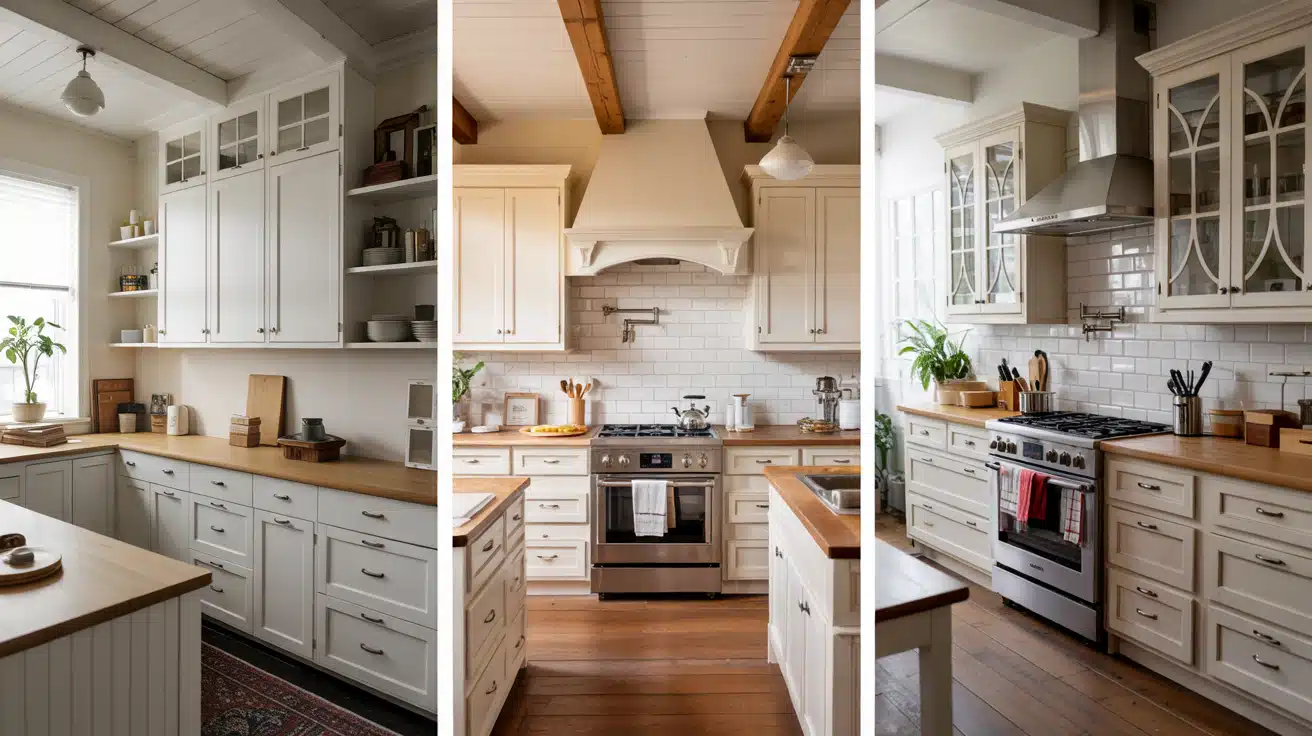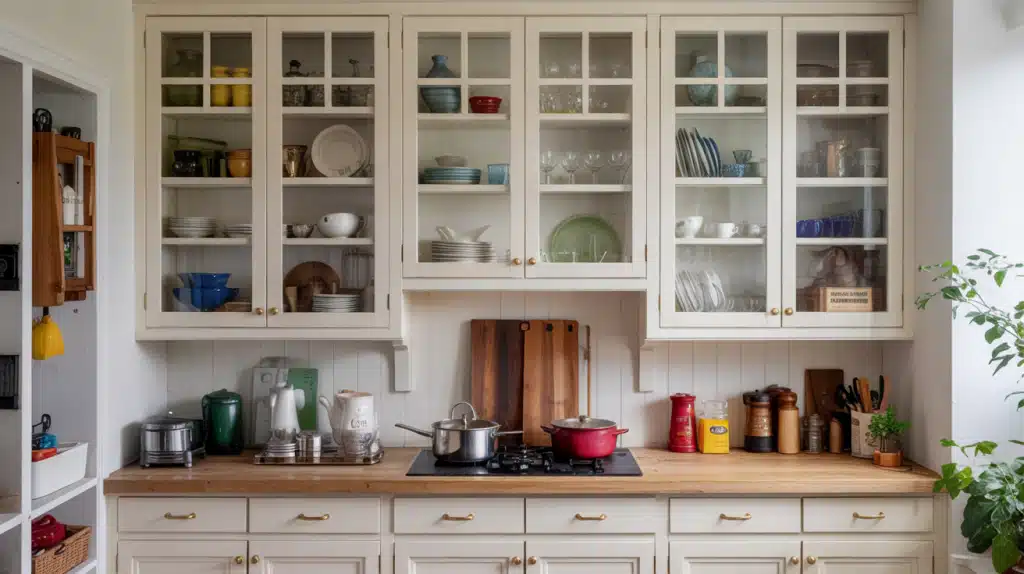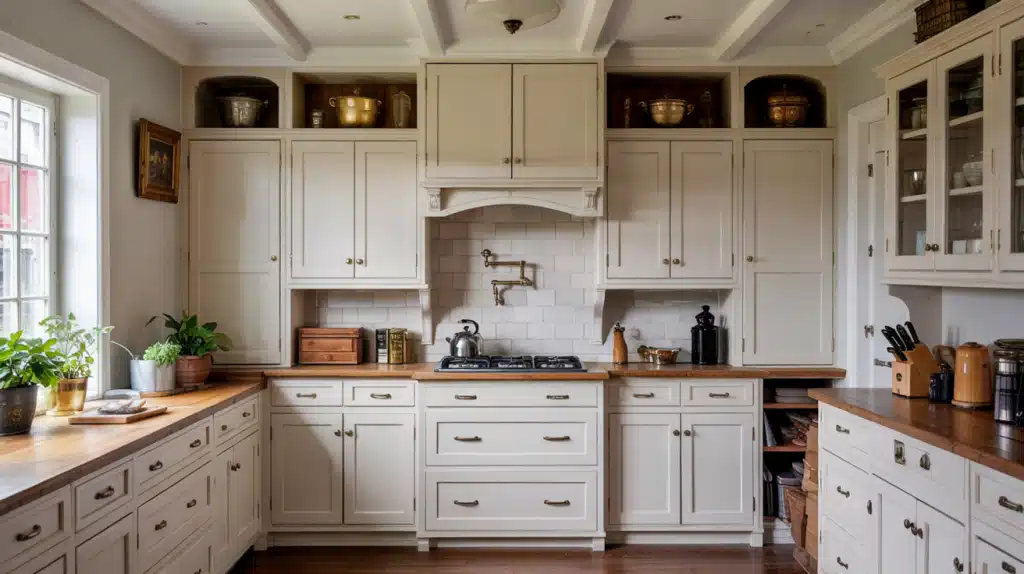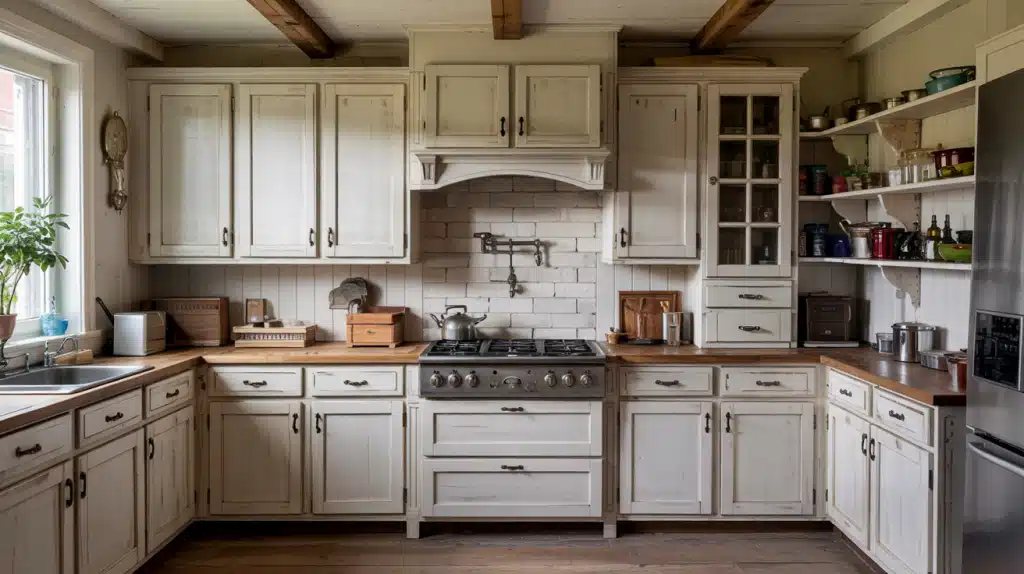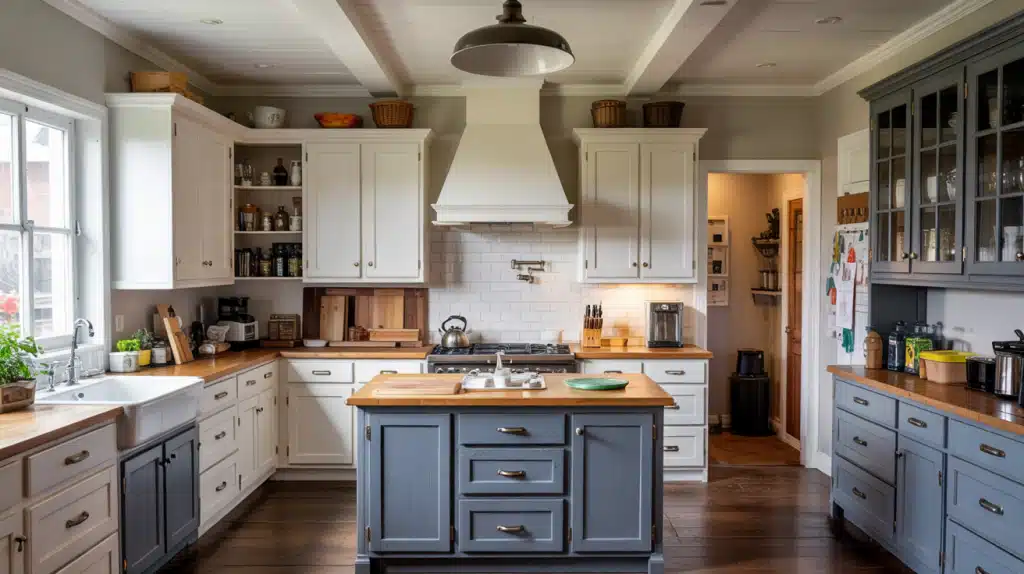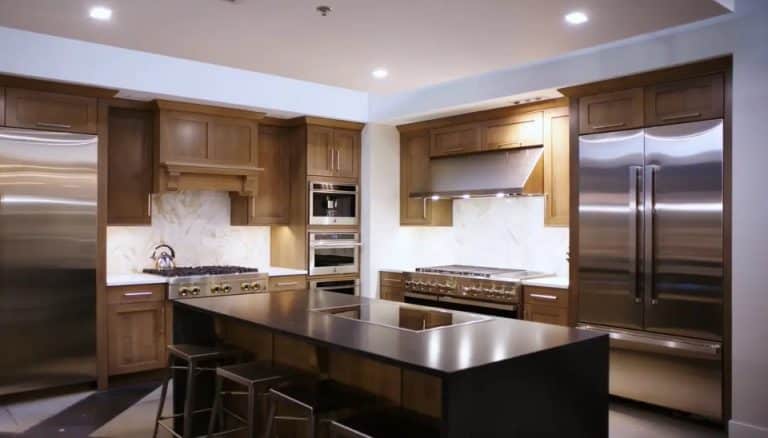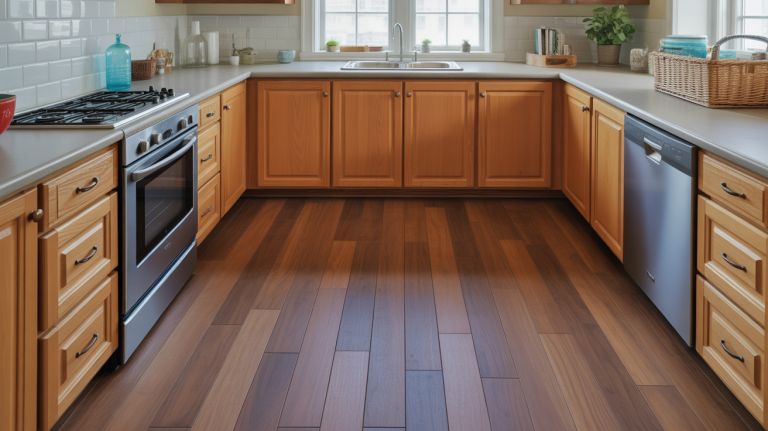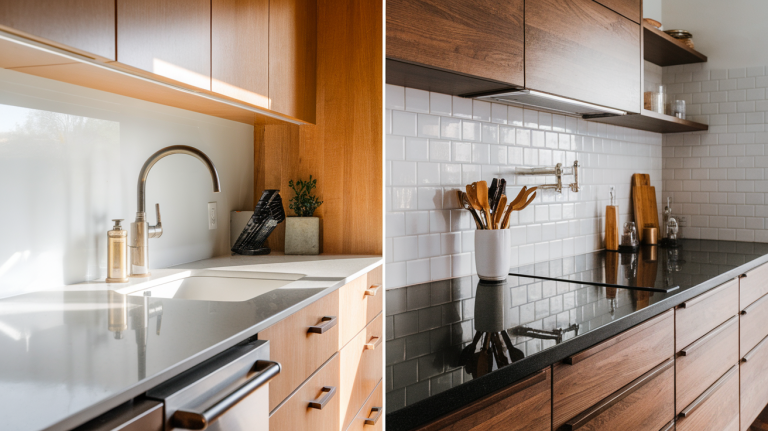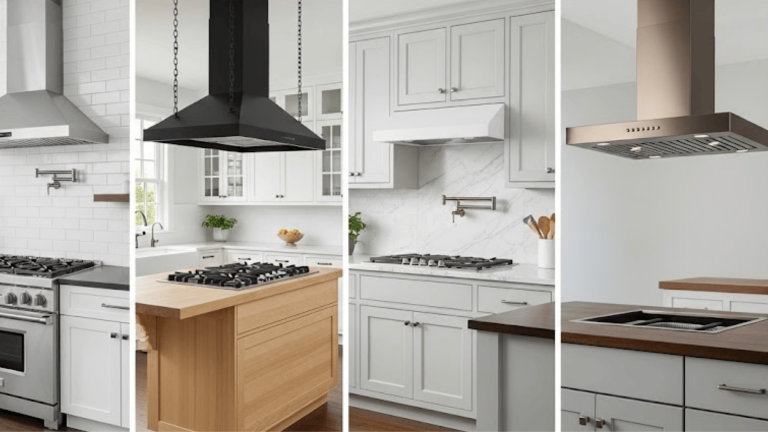11 Popular Kitchen Cabinet Styles Explained
Your kitchen cabinets define more than just storage; they set the entire mood and functionality of your cooking space.
With countless styles flooding the market, choosing the perfect cabinet type can feel overwhelming.
From budget-friendly stock options to luxurious custom designs, each category serves different needs and lifestyles.
The right choice impacts your daily cooking experience, home value, and long-term satisfaction. Some homeowners prioritize timeless appeal, while others crave cutting-edge modern visuals.
Understanding the distinct cabinet types and main construction categories empowers you to make informed decisions that align with your vision, budget, and practical requirements.
Let’s explore each option to find your perfect match.
Kitchen Cabinet Categories Simplified
When planning your kitchen renovation, you’ll encounter three main cabinet construction types that differ significantly in price, timeline, and flexibility.
Stock cabinets are the most budget-friendly option, manufactured in standard sizes and readily available at home improvement stores, though they offer minimal customization beyond finish choices.
Semi-custom cabinets provide the sweet spot for many homeowners, allowing you to modify dimensions, add specialty features, and choose from expanded door styles while keeping costs reasonable.
Custom cabinets represent the premium tier, built specifically for your space with unlimited design possibilities, premium materials, and a perfect fit for unusual layouts, though they require the most significant investment and longest lead times.
11 Kitchen Cabinet Styles That Will Upgrade Your Home
Ready to give your kitchen a fresh new look? These 11 kitchen cabinet styles blend form and function to upgrade your space, whether you’re remodeling or building from scratch.
1. Shaker Cabinets
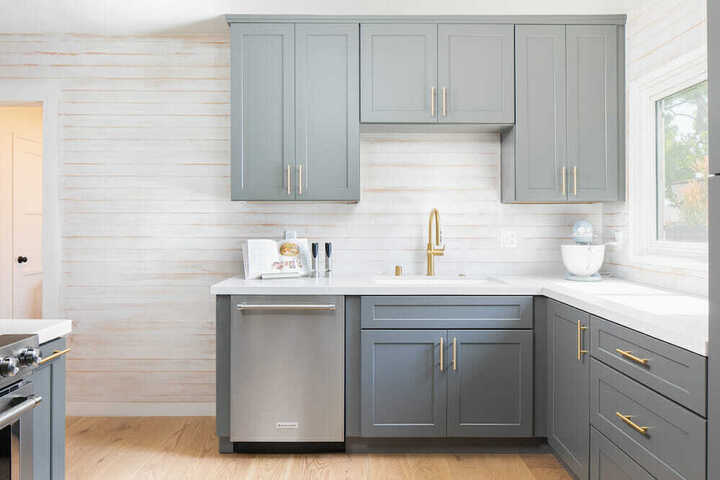
Featuring a simple five-piece door with a recessed center panel, Shaker cabinets represent timeless American craftsmanship.
Their clean lines and minimal ornamentation make them incredibly versatile, working seamlessly across design styles from traditional farmhouse to contemporary spaces.
| Pros | Cons |
|---|---|
| Timeless design appeals to most buyers | It can appear plain in some settings |
| Works with various hardware styles | Limited visual interest compared to ornate options |
| Easy to paint or refinish | A simple design may lack personality for some |
| Widely available and competitively priced | Recessed panels can collect dust and grease |
Best for: Homeowners seeking a classic style that won’t become outdated over time.
2. Flat-Panel / Slab Cabinets
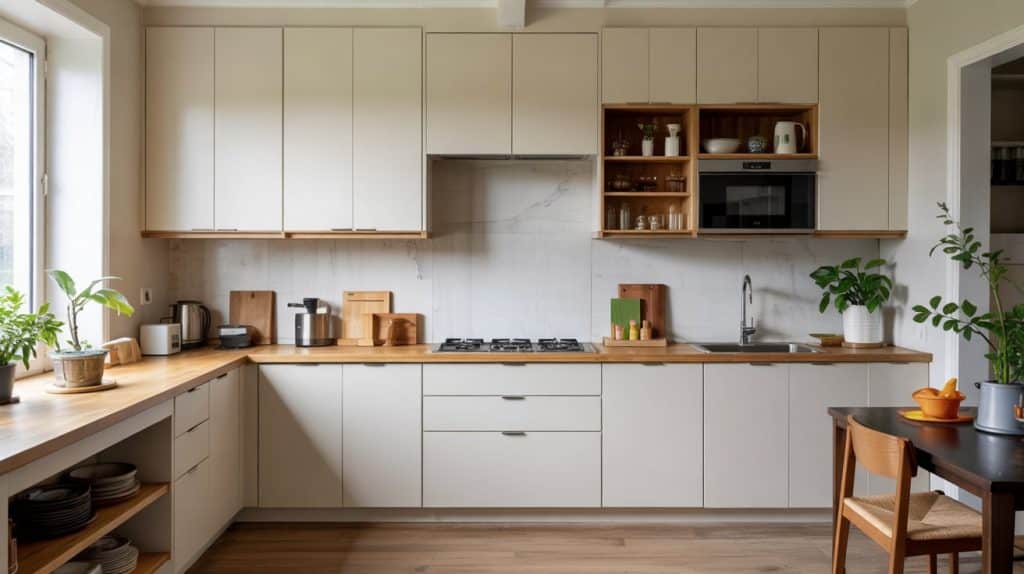
These cabinets feature completely smooth, flat door fronts without any raised or recessed elements.
The streamlined appearance creates a sleek, uninterrupted surface that emphasizes horizontal lines and geometric simplicity.
| Pros | Cons |
|---|---|
| Easy to clean with no crevices | Shows fingerprints and scratches more easily |
| Creates a seamless, modern appearance | Limited texture and visual depth |
| Maximizes the reflection of light | Can feel cold or sterile to some |
| Pairs well with handleless designs | Requires high-quality materials to avoid a cheap look |
Best for: Contemporary and modern kitchens prioritizing clean, minimalist aesthetics.
3. Glass-Front Cabinets
These cabinets substitute solid wood panels with transparent or frosted glass inserts, creating visual depth and openness.
The glass panels can be clear, seeded, frosted, or decorative, allowing you to showcase beautiful dishware while maintaining dust protection.
| Pros | Cons |
|---|---|
| Makes the kitchen feel larger and brighter | Requires organized, attractive content |
| Shows off beautiful dishes and glassware | More expensive than solid doors |
| Adds visual interest and depth | Glass can break and needs replacement |
| Creates focal points in kitchen design | Items inside get dusty despite the glass protection |
Best for: Kitchens where you want to display fine china, glassware, or decorative items.
4. Louvered Cabinets
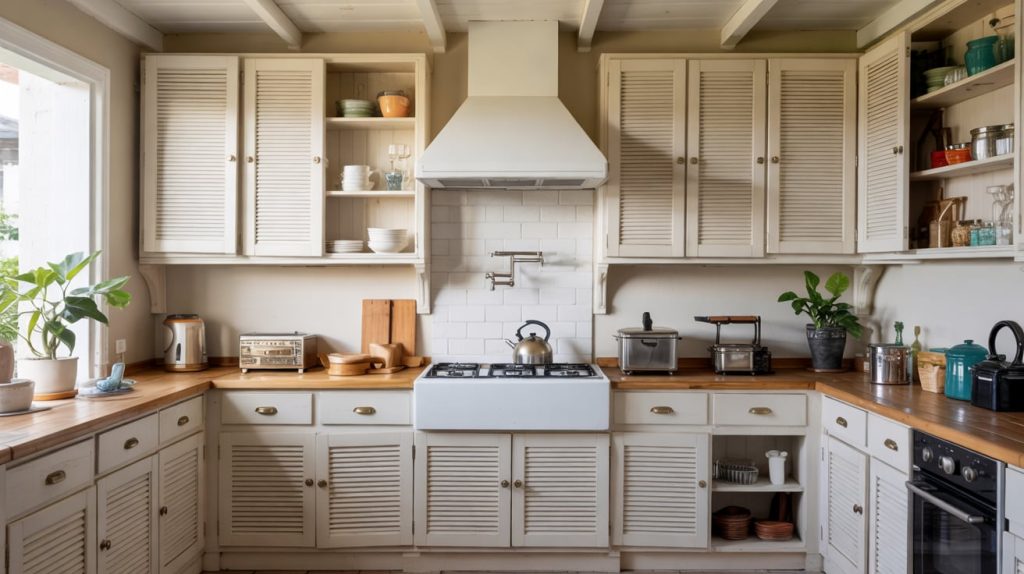
Characterized by horizontal slats that create a distinctive textured appearance, louvered cabinets originated from window shutters.
The angled slats provide subtle ventilation while adding dimensional interest and a relaxed, coastal vibe to kitchen spaces.
| Pros | Cons |
|---|---|
| Allows air circulation for stored items | Slats collect dust and are difficult to clean |
| Adds unique texture and visual interest | More expensive than flat-panel options |
| Creates a relaxed, vacation-home feeling | Limited style compatibility |
| Works well in humid climates | Can look busy in small kitchens |
Best for: Coastal, tropical, or cottage-style kitchens seeking casual, beachy atmospheres.
5. Beadboard Cabinets
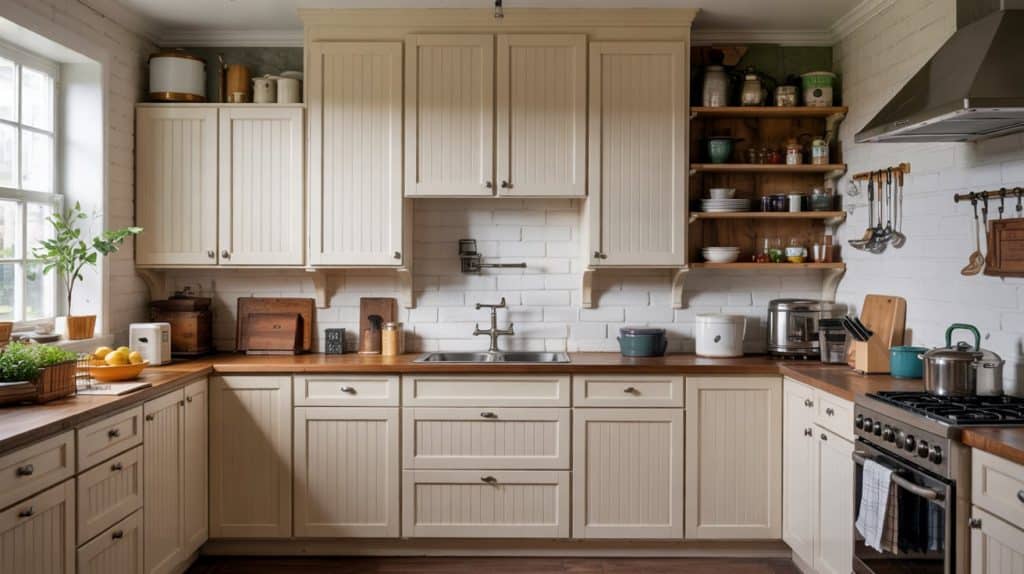
These cabinets feature vertical planks with distinctive grooves or “beads” running between each board, creating a charming cottage aesthetic.
The vertical lines add height to the kitchen while providing rich texture that catches light beautifully throughout the day.
| Pros | Cons |
|---|---|
| Adds warmth and cottage charm | Grooves collect grease and require detailed cleaning |
| Creates vertical lines that add height | Can overwhelm small kitchen spaces |
| Pairs beautifully with vintage hardware | Limited to casual, country design styles |
| Relatively affordable compared to custom options | Vertical lines may clash with other patterns |
Best for: Farmhouse, cottage, or country-style kitchens emphasizing cozy, homey feelings.
6. Inset Cabinets
The door and drawer fronts sit thoroughly flush within the cabinet frame, creating a smooth, integrated appearance.
This construction method requires precise craftsmanship and represents the highest quality cabinet installation, often found in luxury homes and high-end renovations. Many premium inset cabinets also use durable materials like baltic birch plywood, offering exceptional strength and long-term stability.
| Pros | Cons |
|---|---|
| Represents the highest quality construction | Most expensive cabinet style available |
| Creates a smooth, refined appearance | Requires skilled installation and precise measurements |
| Increases home value significantly | Seasonal wood movement can affect door fit |
| Timeless style with luxury appeal | Limited hardware options due to flush design |
Best for: Traditional or transitional kitchens where quality craftsmanship is the primary concern.
7. Distressed Cabinets
These cabinets receive special finishing treatments to create an aged, weathered appearance with intentional imperfections.
Techniques include sanding, glazing, and strategic wear patterns that simulate decades of natural aging, perfect for vintage-inspired kitchen designs.
| Pros | Cons |
|---|---|
| Hides everyday wear and minor damage | Distressing can look artificial if poorly executed |
| Creates a unique, one-of-a-kind appearance | Limited resale appeal to modern design preferences |
| Adds instant character and history | More expensive than standard finishes |
| Works well with antique hardware | Difficult to repair or touch up later |
Best for: French country, shabby chic, or rustic kitchens wanting authentic vintage character.
8. Open Shelving Cabinets
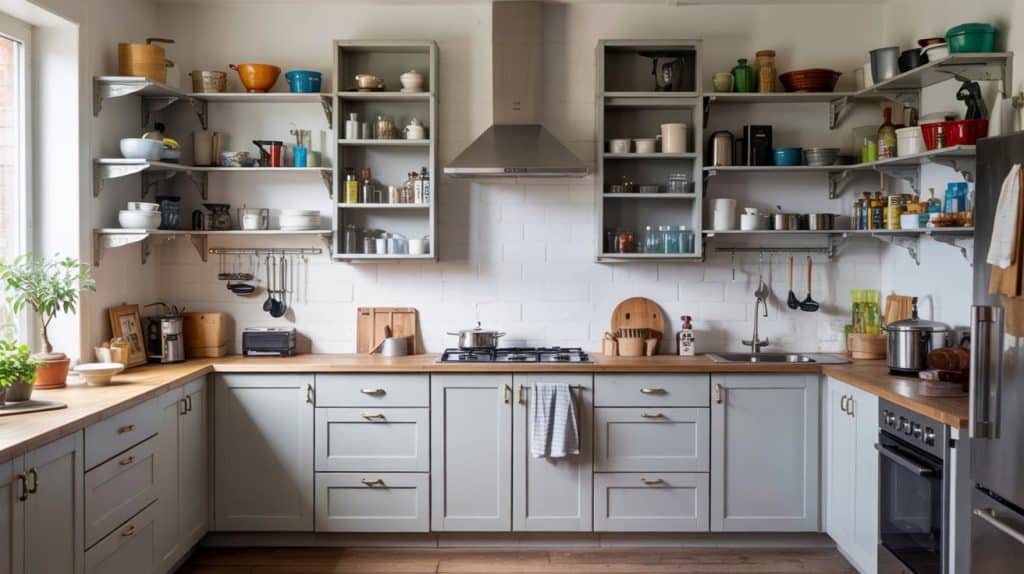
Eliminating doors entirely, these storage solutions feature exposed shelves that create an airy, spacious feeling.
Open shelving can be integrated with traditional cabinets or used exclusively, requiring careful organization since contents remain constantly visible.
| Pros | Cons |
|---|---|
| Makes the kitchen feel larger and more open | Items get dusty and require frequent cleaning |
| Easy access to frequently used items | Everything must be organized and attractive |
| Less expensive than traditional doors | Does not protect from cooking grease |
| Encourages a minimal, organized lifestyle | Reduces overall storage capacity |
Best for: Modern farmhouse, industrial, or contemporary kitchens prioritizing openness over concealed storage.
9. Thermofoil Cabinets
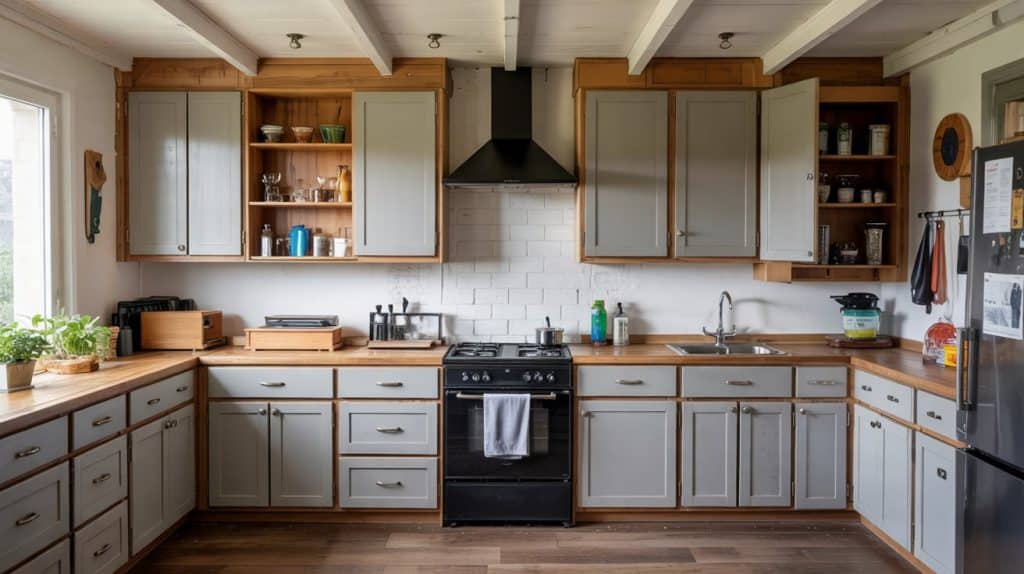
These cabinets feature medium-density fiberboard cores wrapped in a durable vinyl coating that resists moisture, stains, and everyday wear.
The thermofoil process creates smooth, consistent finishes available in numerous colors and wood-grain patterns at affordable price points.
| Pros | Cons |
|---|---|
| Highly affordable compared to wood options | Cannot be painted or refinished |
| Resists moisture and stains effectively | Can peel or bubble with excessive heat |
| Easy to clean with simple soap and water | Limited repair options if damaged |
| Available in many colors and finishes | May not add significant home value |
Best for: Budget-conscious homeowners needing durable, low-maintenance cabinet solutions.
10. Two-Tone Cabinets
This design approach combines different colors or finishes on upper and lower cabinets, creating visual contrast and depth.
Popular combinations include white uppers with dark lowers, or natural wood mixed with painted finishes for dynamic, personalized kitchen aesthetics.
| Pros | Cons |
|---|---|
| Creates visual depth and personality | It can look dated if trend colors are chosen |
| Allows creativity in color combinations | More complex to coordinate with other elements |
| Can make ceilings appear higher | May limit future decorating flexibility |
| Helps define different kitchen zones | Requires careful color selection for balance |
Best for: Homeowners wanting to add personality and visual interest without major structural changes.
If you’d like to explore even more creative combinations, check out these inspiring two‑tone cabinet ideas for design inspiration.
11. Corner Cabinets
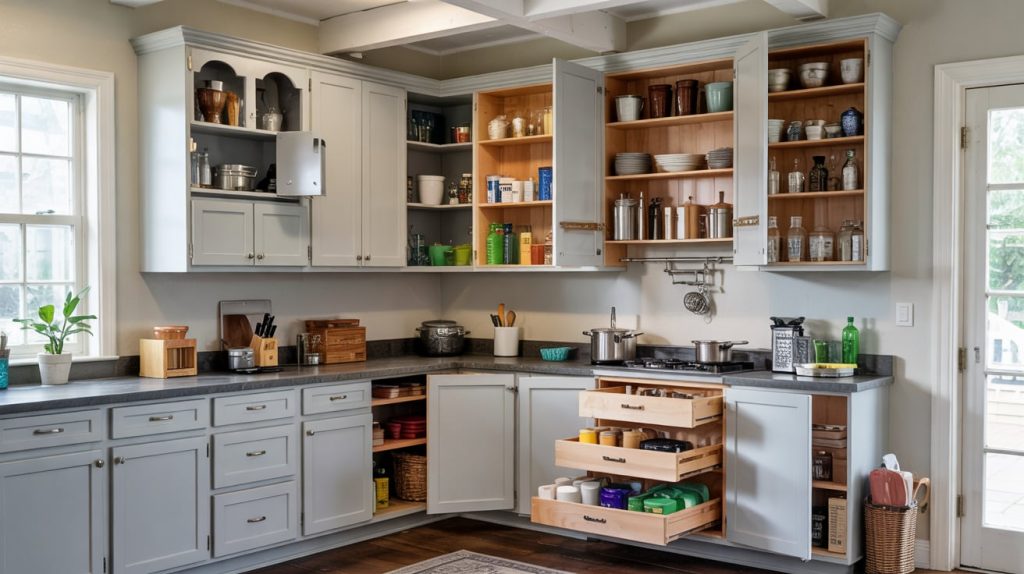
These specialized cabinets maximize storage in challenging corner spaces through rotating shelves or angled designs.
Lazy Susan mechanisms allow easy access to items stored in deep corners, while diagonal cabinets create accessible storage without dead space.
| Pros | Cons |
|---|---|
| Maximizes storage in difficult corners | Moving parts can break and need maintenance |
| Provides easy access to stored items | More expensive than standard cabinets |
| Eliminates hard-to-reach dead space | Limited storage for large or oddly shaped items |
| Available in various rotating configurations | Requires precise installation for proper function |
Best for: Kitchens with corner spaces that need efficient, accessible storage solutions.
The Bottom Line
Selecting the perfect kitchen cabinets involves balancing style preferences, budget constraints, and practical needs.
From timeless Shaker designs to sleek flat-panel options, each cabinet type offers unique benefits that can change your cooking space.
Stock cabinets provide affordability, semi-custom options offer flexibility, while custom designs deliver unlimited possibilities.
Consider your lifestyle, maintenance preferences, and long-term goals when making this significant investment. Remember that quality cabinets enhance both daily functionality and home resale value.
Take time to evaluate your kitchen layout, storage requirements, and design vision before committing.
The right cabinet choice will serve your family for decades while creating a space you’ll love spending time in every day.
Cooking up style? See more kitchen and dining ideas worth saving.
Frequently Asked Questions
What Are Level 3 Cabinets?
Level 3 cabinets refer to premium-grade custom cabinets with high-end materials, advanced construction techniques, and luxury finishes that represent the top tier in cabinet quality and pricing.
What Type of Material Is Best for Kitchen Cabinets?
Solid hardwood (maple, oak, cherry) offers the best durability and longevity, while plywood construction provides excellent stability and moisture resistance at a more affordable price point.
What is a 5 5-piece kitchen Cabinet?
A 5-piece kitchen cabinet door consists of four frame pieces (two rails and two stiles) plus one center panel, creating the classic Shaker or raised-panel door style.
What is a PVC kitchen Cabinet?
PVC kitchen cabinets feature doors and frames made from polyvinyl chloride plastic, offering excellent moisture resistance, easy maintenance, and affordability compared to traditional wood options.

